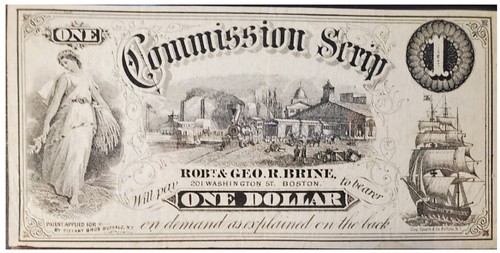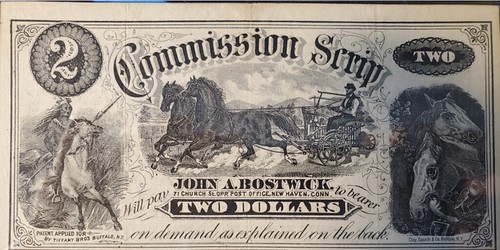
PREV ARTICLE
NEXT ARTICLE
FULL ISSUE
PREV FULL ISSUE
V25 2022 INDEX E-SYLUM ARCHIVE TIFFANY COMMISSION SCRIPThe June 2022 issue of Nena News from the New England Numismatic Association has a nice article by Gary E. Lewis titled "Panic of 1873 In New England." It's about Tiffany commission scrip, produced for New England merchants following the financial Panic of 1873. With permission, we're republishing it here. Many thanks to John Ferreri for assistance. -Editor The period following the Civil War was a time of expansion and rapid growth for New England. New industries like milling, lumber, fishing, and other enterprises all formed what is now known as the Golden Age.
As most numismatists know, currency in the 1870's and for most of the
nineteenth century was based on specie. Metal money circulated in New
England, and many local state banks issued paper banknotes backed by
the supply of gold and silver. This system changed due to financial demands imposed by the Civil War. President Lincoln authorized the printing of Demand Notes in 1861, called Just twelve years later, the Panic of 1873 became the first global depression brought about by industrial capitalism. Banks raised millions of dollars through selling bonds to finance construction of the westward expansion of the railroad. However, construction expenses ballooned and outpaced financing, thus efforts to raise additional funds failed. While only the first of many market corrections, the effects of the downturn when Jay Cooke & Company closed its doors in September 1873 were severe and unexpected. It began a regular pattern of boom-and-bust cycles that continues to this day in New England.
This 1873 panic effected numerous small businesses throughout the New
England area. During the late 19th and early 20th century, many companies used currency Oscar F Tiffany started his sales promotion of commission scrip in Detroit and later moved to Buffalo where his brother Nelson joined him in the business. The business was located at 265 Washington St, Buffalo NY. Clay Cossack Co and White & Brayley Co., lithographers, printed the scrip in the Buffalo area. The lithographed Tiffany scrip was normally printed in two formats, a dollar size (6.5 x 3 inches) and a smaller fractional size (3.5 x 2 inches). The fractional scrip was printed to conform to the government fractional size of the government fractional currency then in general circulation. Most of the Tiffany scrip is printed with black ink on white bank note paper. A few examples of brown ink on white paper exist. Tiffany scrip exists in denominations from ten cents to $50 dollars. The obverse, or face, of each scrip typically has a one or two beautiful vignettes and the vendors name, line of goods, and address. The reverse, or back, of the scrip typically has a redemption statement like redeem the note for $5 used in conjunction with a cash purchase of $100 or more. The purpose of the scrip was to encourage the return of customers by offering a discount or commission on the next cash purchase. The scrip was accepted only at the retail establishment named on the scrip. For those of you who collect Tiffany commission scrip, I am sure you find it a challenging task because of the rarity of the scrip. Even though fifty-eight merchants in the New England area utilized the Tiffany scrip as a marketing tool, I believe most scrip is R-7 or higher on the rarity scale. A long-time friend of mine, Gene Hynds, who spent years studying and collecting Tiffany scrip was able to locate Tiffany scrip issued in the New England states by merchants in Connecticut, Maine, Massachusetts, and Rhode Island. Gene's Connecticut records reflect notes issued in Danbury, Hartford, and New Haven by three different merchants. Furthermore, his Maine records reflect notes issued in Auburn, Augusta, Bangor, Belfast, Gardner, Hallowell, and Lewiston by nineteen merchants. The largest number of Tiffany scrip was issued in the following cities in Massachusetts: Arlington, Belfast, Beverly, Boston, Brighton, Cambridgeport, Fitchburg, Haverhill, Hyde Park, Lowell, Lynn, Natick, Northamp- ton, Palmer, Provincetown, Salem, Somerville, Springfield, Stoneham, Wakefield, Waltham, Ware, Webster, and Worcester by thirty-five merchants. Only one merchant in Providence issued scrip in Rhode Island according to Gene's records. Collecting numismatic items like Tiffany Scrip can be a fun and enjoyable part of this great hobby we all enjoy.
For more information on the New England Numismatic Association, see:
Wayne Homren, Editor The Numismatic Bibliomania Society is a non-profit organization promoting numismatic literature. See our web site at coinbooks.org. To submit items for publication in The E-Sylum, write to the Editor at this address: whomren@gmail.com To subscribe go to: https://my.binhost.com/lists/listinfo/esylum All Rights Reserved. NBS Home Page Contact the NBS webmaster 
|


